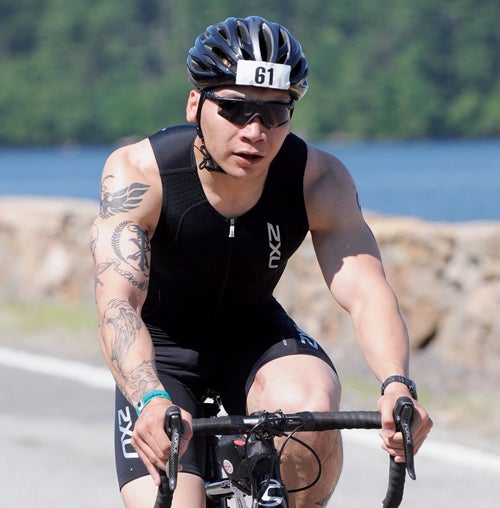Long Ride Home
 Terry Rajsombath survived a devastating injury in Afghanistan to walk swiftly into a new life.
Terry Rajsombath survived a devastating injury in Afghanistan to walk swiftly into a new life.
Sitting in a classroom at the University of Rhode Island, he found his mind wandering to the ridge in Afghanistan where he nearly died. Once again, he heard the crackle of gunfire and felt a burning pain in his hip. The sky was blue.
It’s an image that comes back to Terry Rajsombath ’16 so often he now realizes it will be with him forever—and he says that’s not a bad thing. His brush with death inspired the 27-year-old URI student and Purple Heart recipient to push himself even more—in and out of the classroom.
“I’m going to climb Mount Everest some day,’’ he says. “I don’t know when, but I’ll do it. It’s on my bucket list.’’
The bullet he took that day outside a dusty town in Lagham Province ricocheted through his body and shattered his left hip, leaving him unable to run—forever. But he can walk, and he does with great purpose.
Two years ago, he competed in the Amica Ironman 70.3 Rhode Island, swimming 1.2 miles, bicycling 56 miles and walking 13.1 miles, relying on his crutches for support. That was a warm up for a bigger and more grueling race in August—the Ironman North American Championship in Quebec, where he swam 2.4 miles, bicycled 112 miles and walked a staggering 26.2 miles.
There’s a reason “discipline’’ is tattooed on his arm. Despite his bad hip and busy life, he trained over the summer, putting in 80 miles on his stationary bike every Sunday and swimming hundreds of laps at a pool. His 5-foot-7-inch frame of pure muscle is proof of his persistence. But fitness wasn’t his only reason for competing.
“I did it for Grace,’’ he says. Grace is a little girl who has neurofibromatosis, a genetic disorder that causes tumors, often cancerous, to form on nerve tissue. She is also a sponsor child with the Children’s Tumor Foundation, the charity Rajsombath raised money for in the race. “I don’t want to let these kids down,’’ he says. “If I can help find a cure, that’s great.”
A child of Laotian immigrants, Rajsombath grew up in Providence and Johnston. After high school, he worked as a mechanic, but quit after three years to go after his dream of being a soldier, or as he puts it, a “grunt.’’ In 2009, he enlisted in the Connecticut National Guard and was soon living in Najil, a volatile region in northeastern Afghanistan. “They called my area IED Valley,’’ he says.
He learned quickly about the precariousness of life. “I’d wake up in the morning and be amazed at the beauty of the country and then remember, ‘Oh yeah, people are trying to kill us.’ ’’ Rocket-propelled grenades flew out of nowhere. Mortars whizzed overhead. “You don’t have time to be scared. You just move.’’
The morning of July 3, 2010, he awoke in an odd mood. He’d been in Afghanistan for six months and was about to take a two-week leave to teach English at an orphanage in Peru. He had celebrated his 24th birthday the day before. “I thought everything was too good to be true.’’
The mission was supposed to be short. Patrol a nearby town and be back to Najil by noon. He grabbed his Mark 48 and headed out. Midway down the road, shots rang out. Everyone scrambled for cover in the ambush. Terry was pinned down under a small ridge.
The bullet hit him from behind and tore into his thigh. Razor-sharp pieces of shrapnel exploded in his hip. The pain was so intense he couldn’t even scream. His fingers clawed the hard stone in agony. “It was like someone stabbed me in the thigh with a red-hot dagger and then went in with his hand and started tearing up my muscles.’’ He decided not to die, not there, not on a rock in Afghanistan far away from “the ones I love, in a country filled with so much hate.’’
Using his machine gun as a crutch, he picked himself up. He rolled down one ridge, then threw himself off another, landing belly-first in a puddle of water. “Dude, stay with me!’’ his buddies shouted as they dragged him to safety. He spent 10 months at Walter Reed Army Medical Center in Washington, D.C., enduring 12 operations, mostly to remove shrapnel. A chunk of his hip was gone. Doctors told him he would never run again and that he would need a hip replacement someday. He was devastated. His days on the battlefield were over.
That reality forced him to create a new life, with no self-pity. “I went through some existential stuff,’’ he says, “then moved on.’’ And with gusto. Besides taking on Ironman races, he hiked to the ancient Incan city of Machu Picchu and witnessed the dancing lights of the Aurora Borealis. He started reading philosophy—Nietzsche and Kierkegaard—and turned a room in his Cranston apartment into a photography studio. One day, he’d like to learn how to make pastries and play Pachelbel’s Canon in D on the guitar.
Being on a college campus after his near-death experience has its challenges. He’s finally getting his college degree, but he’s an older student who keeps to himself and rarely shares his story with classmates. “I’m a loner,’’ he says. “But if anyone asks, I’ll tell them.’’ After graduating with a degree in health studies, he hopes to work for a nonprofit that helps dissidents in North Korea—that is, when he isn’t moving mountains.
“I want a job that has a little bit of danger and a lot of meaning,’’ he says. “My life isn’t bad. I can’t complain. I’m alive.’’
—Elizabeth Rau
 Home
Home Browse
Browse Close
Close Events
Events Maps
Maps Email
Email Brightspace
Brightspace eCampus
eCampus


